Student Notable
Sports & Recreation Award
Core77 Design Awards 2019
Cara: Nothing Will Stop Us. Period.
Cara is a menstrual product and waste carrier designed for use in multi-day trips outdoors. It features an expandable waste collection container at the center, and two separate dry enclosures at the top and bottom to keep unused menstrual products, toilet paper and wipes clean and ready to use.
Cara was conceived during Alexia's MFA thesis titled Dare + Defy: A Women's Place in the Great Outdoors. Through a human-centered design approach Alexia conducted interviews with women and experts in the field. Through these conversations and further secondary research it became clear that most women would not let menstraution stop them from engaging in the outdoors. While their waste collection hacks were varied, most of them carried and collected their menstrual products using ziplock bags and duck tape. Not a surprising behavior, since no product had ever been designed for this specific purpose. This created an opportunity for a designer focussed on empowering women in this sphere to make a mark.
Practically speaking, what makes Cara most effective is that by combining all the storage needs in one product, it eliminates the need to rummage through a backpack for all the elements required every time one has to change a menstrual product (approximately every 3-5 hours). At the core, Cara opens up the conversation to stakeholders in the industry. It is true that the hacks women have come up with are great examples of adaptability and resilience that will continue to be effective; Cara simply questions the fact that women should be limited to them, just because no one has invested the time and resources to solve for this need. Cara is not only a viable solution to this challenge, but an empowering representation that women-specific needs can actually be met through design. Most critically, Cara honors women's experiences and celebrates our place in the great outdoors. It does so by conspicuously displaying that yes, we menstruate, it is part of being a woman, and we will not let it stop us from doing what we love.
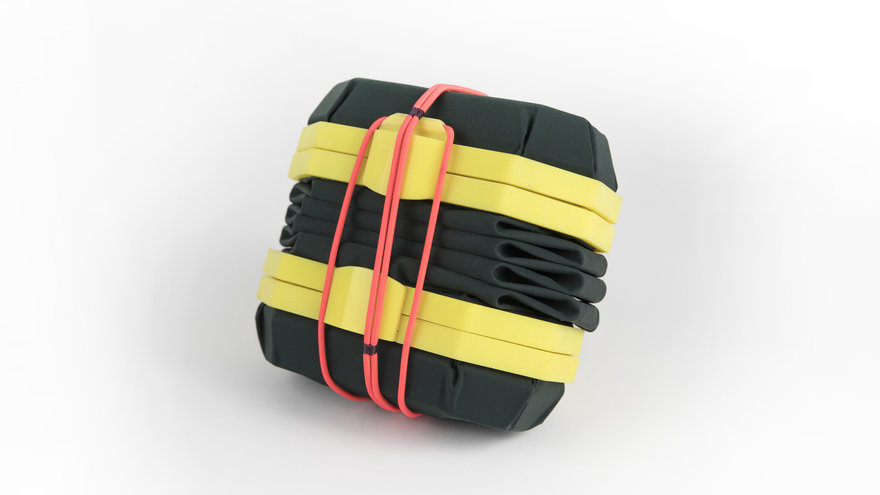 Cara
Closed and compact form
Alexia Cohen
Cara
Closed and compact form
Alexia Cohen
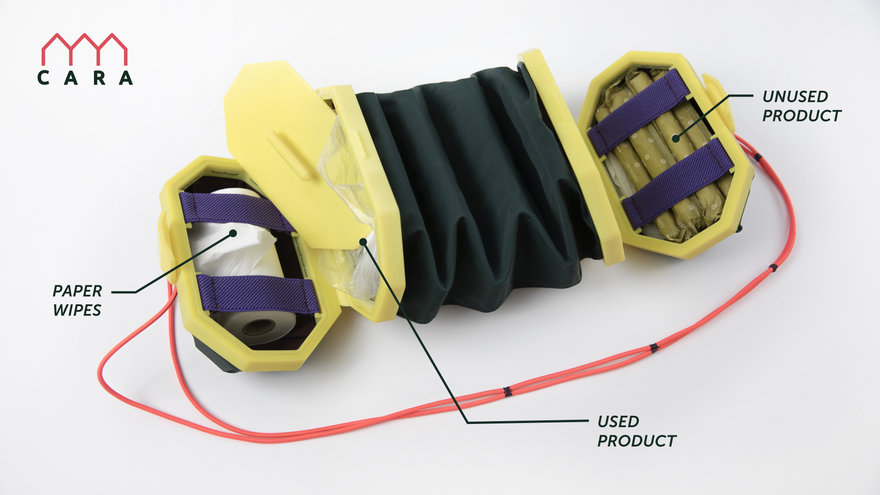 Cara detail
Logo and features
Alexia Cohen
Cara detail
Logo and features
Alexia Cohen
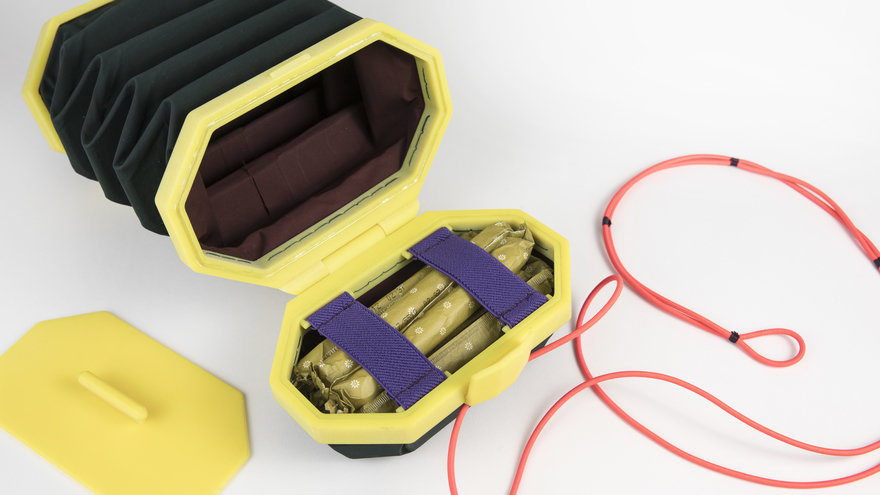 Cara detail
Enclosure and storage
Alexia Cohen
Cara detail
Enclosure and storage
Alexia Cohen
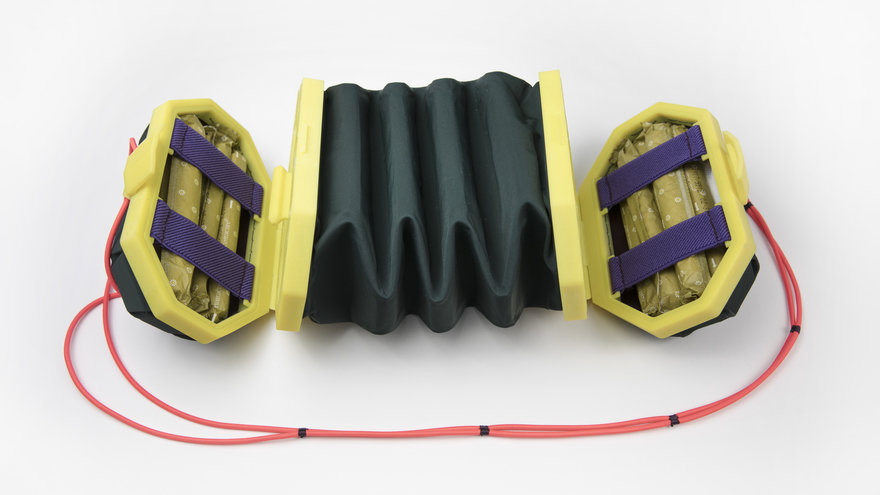 Cara detail
Alexia Cohen
Cara detail
Alexia Cohen
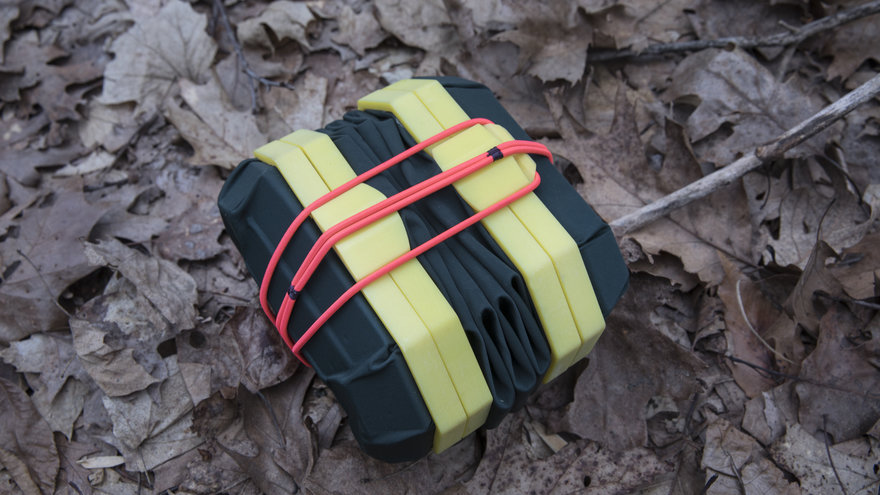 Cara Outside
Alexia Cohen
Cara Outside
Alexia Cohen
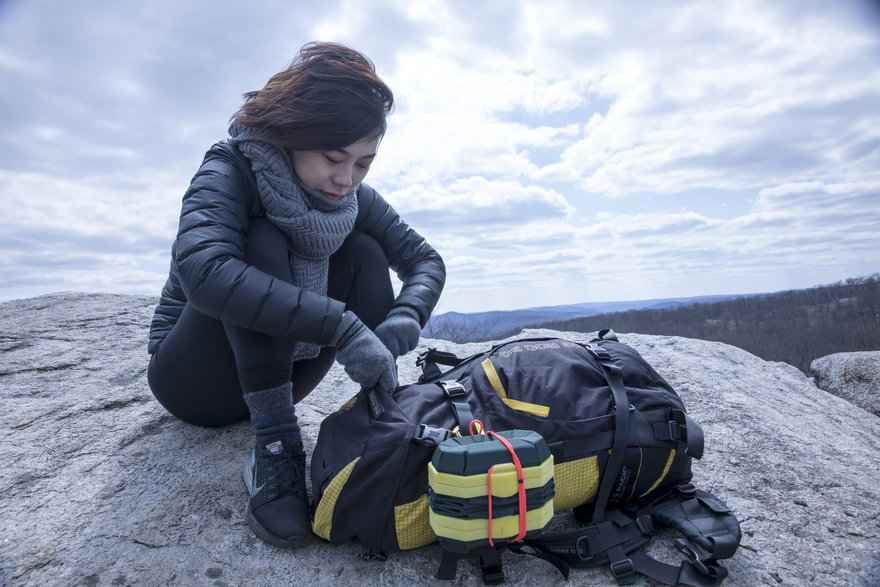 Cara in Use
Alexia Cohen
Cara in Use
Alexia Cohen
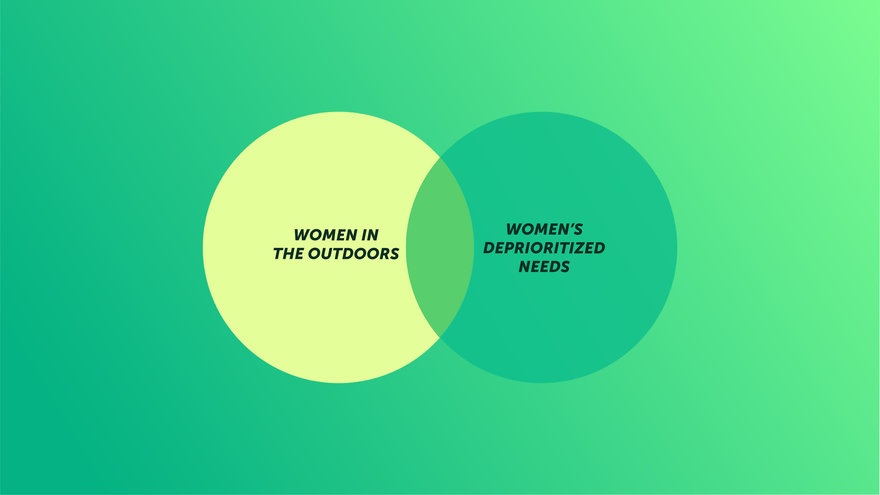 Cara Venn Diagram
Cara effectively works at the intersection of designing for women in the outdoors and designing for women's needs that are typically deprioritized.
Alexia Cohen
Cara Venn Diagram
Cara effectively works at the intersection of designing for women in the outdoors and designing for women's needs that are typically deprioritized.
Alexia Cohen
 Process: Research and Current Hacks
Research revealed the kinds of hacks women come up with and created an opportunity for design.
Alexia Cohen
Process: Research and Current Hacks
Research revealed the kinds of hacks women come up with and created an opportunity for design.
Alexia Cohen
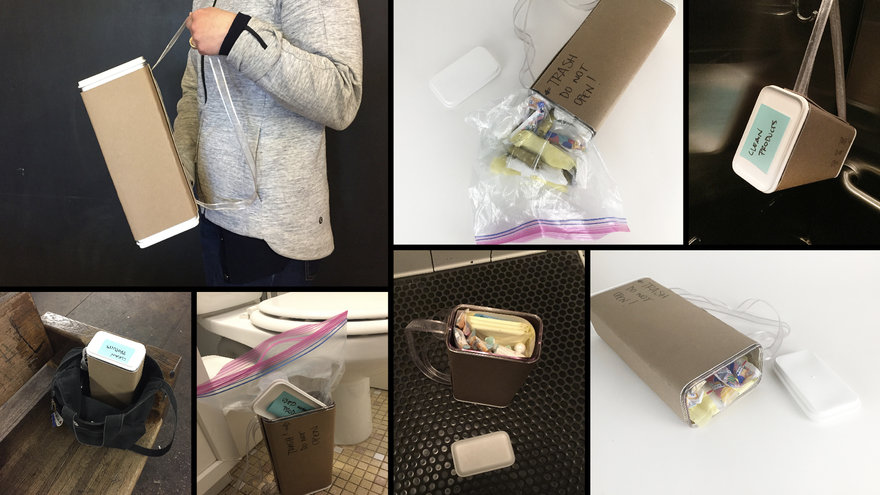 Process: 1st Works-like Prototype
This prototype enabled Alexia to learn about the amount of waste generated during one cycle as well as test the utility of the product.
Alexia Cohen
Process: 1st Works-like Prototype
This prototype enabled Alexia to learn about the amount of waste generated during one cycle as well as test the utility of the product.
Alexia Cohen
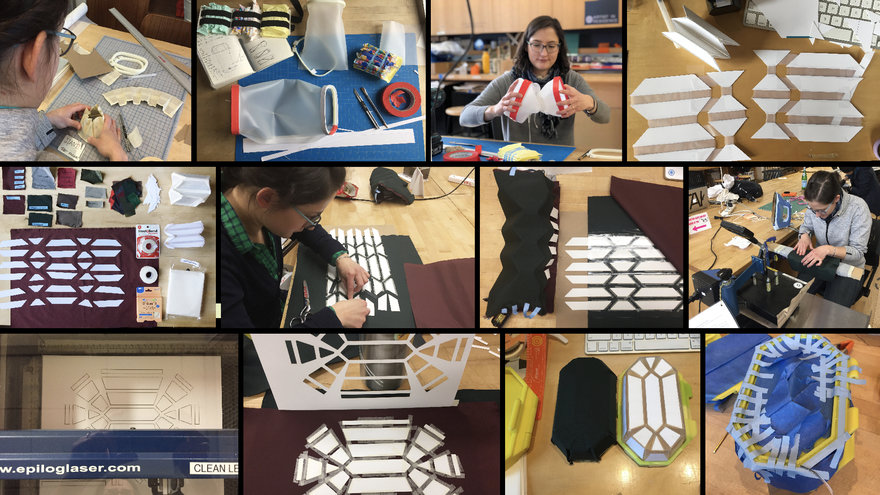 Process: 2nd and Final Prototypes
Building an articulated and collapsible structure required various iterations and material experiments.
Alexia Cohen
Process: 2nd and Final Prototypes
Building an articulated and collapsible structure required various iterations and material experiments.
Alexia Cohen
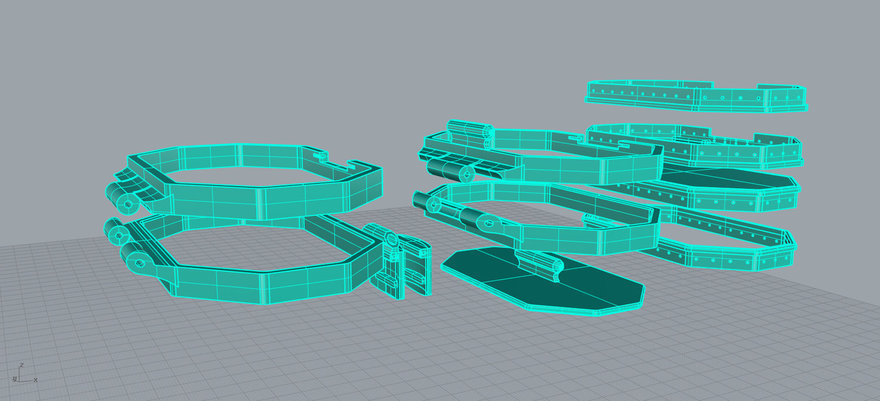 Process: 3D Model
The hinged/rigid parts were designed on Rhino and 3D printed in hard plastic.
Alexia Cohen
Process: 3D Model
The hinged/rigid parts were designed on Rhino and 3D printed in hard plastic.
Alexia Cohen
DESIGN PROCESS
RESEARCH
What do women do now when they have their period while engaging in outdoor activities?
Early on in my research, I engaged in conversations with several women who were guiding multi-day trips in the outdoors. While speaking to Rebecca Stamp, I inquired about the challenges of dealing with menstruation while engaging in these long trips out-of-doors. This was a perfect question for her as she had been guiding trips for teenage co-ed groups at Apogee Adventures in Maine the previous summer. It entails dealing with the waste the same way you would deal with any other waste: you pack it out—including your used toilet paper—following the “Leave No Trace” ethos. Personal waste is collected by members of both genders and they each bring their own ziplock bag, which they cover with duct tape to make it more durable, to hide the contents, and to indicate that it is their personal waste bag. Women also pack their unused feminine hygiene products in another ziplock bag to keep them dry and protected.
In A Woman's Guide to the Wild: Your Complete Outdoor Handbook by Ruby McConnell, she writes about the way in which women hack together a bin using an empty tube of antibacterial wipes, lined with a bag to collect their personal waste. At times, they also attach a pouch of cleansing wipes to the side of their trash container for convenience. In this way they can keep this bin strapped to the side of their pack for easy access. With this solution, they need to keep their unused products protected elsewhere. McConnell also encourages the use of a menstrual cup, since it eliminates waste completely, but this is an option that many women are still not comfortable using. As an experienced outdoor guide Hannah Rudin expressed that the issue with the menstrual cup in these situations is that one’s hands may not necessarily be as clean as they should be to handle this option in a sanitary way; she thinks that tampons with applicators or pads and liners are much safer options.
I was curious to get more opinions, and see if anyone had actually designed a product for this purpose, so I went online looking for discussion forums and potential products. Browsing through the Leave No Trace website (www.lnt.org), I found waste collection bags, bear canisters, and a small trowel to dig cat holes for human waste, but nothing specific for women’s menstrual needs.
I then turned to a facebook group called All Women All Trails: Hiking & Backpacking, an incredible community of over 25,000 women from all over the world who share tips and tricks, favorite spots to hike, and gear reviews. I decided to post a question about periods in the outdoors. In a matter of a mere 48 hours I had received a varied range of about 200 responses from the community. While many advocated for the menstrual cup as well as Thinx menstrual underwear, a lot of them also still used the duct tape/ziplock bag method to store their used tampons and pads. This confirmed the fact that there is indeed an opening to design intentionally for this purpose, as enough women are still using disposable products out of preference and need.
WORKS-LIKE PROTOTYPING AND TESTING
To begin my design process, I needed to figure out what size container would be appropriate to hold both the unused as well as the used products. To build my first works-like prototype, I went to the Container Store and bought a few small plastic containers that I estimated could hold both. I then glued the two containers’ bottoms together and created a quick semi-rigid tube in chipboard that I used to cover the contents and add a handle. Next time my period came, instead of throwing the used products in the trash, I collected them all in the container I had created. I hauled this prototype around between my apartment and school every day, and at the end of my cycle I had a pretty good sense of the special needs to be considered for such a device. I was surprised to see the bulk of the waste created—since we throw this waste into so many different bathroom bins throughout the cycle, it’s hard to have an overview—and I had definitely underestimated the amount of storage space required on that side of the container. This was especially important to note since I had only stored used menstrual products, without including the used toilet paper which I flushed, but which I would have had to collect in the outdoors. The following are the four key conclusions from this first prototype:
1. Space for waste needs to be bigger, with an option to explore a soft container that might expand as it is used. This would help to keep the object as compact as possible.
2. Having the unused product lid on the opposite end of the trash lid made use of the product clunky and impractical. Two easy solutions came to mind: have the used and unused product lids facing each other and use a hinged lid mechanism.
3. The container should have a space to store clean toilet paper and/or wipes.
4. Some rigidity around the unused products helps to keep them protected and functional.
Once I arrived at these conclusions, I moved-on to creating a second prototype. In looking at ways to hold soft materials on rigid frames, I realized I could use an embroidery hoop-type mechanism to make such a transition. With this new iteration I started exploring ways in which the middle trash section could become collapsible while the ends of the product remained rigid enough to provide some structure to the overall form.
FINAL PROTOTYPE
The collapsible mid-section of the second prototype was flexible enough to work, but I needed to find a way to make this collapsible feature a bit more intentional. I began to explore the use of origami patterns and settled with a pattern much like an accordion, which provided function and design intention. Once the pattern was set in paper and tape, I pushed on to testing this technique using nylon fabric, a laser cut paper pattern, and heat bonding tape. After a few failed attempts at laying down the pattern effectively, I perfected my process and was able to create the final fabric pieces with precision.
While the soft pieces were in development, I was also working on 3D modeling the hard hinged frames on Rhino. Connecting the two pieces (hard and soft) both mechanically and visually was challenging, but ultimately the accordion pattern dictated the shape of the frame.
The end product features two end caps that hinge and latch onto the main body to contain both the unused feminine hygiene products as well as some toilet paper and wipes. The main body has its own cap to keep the used contents separate from the clean products. Even though the material is waterproof, this section should be lined with a plastic bag for ease in disposal and clean-up.
Core77 Design Awards 2019
- Built Environment
- Commercial Equipment
- Consumer Technology
- Crowdfunding
- Design Education Initiative
- Design for Social Impact
- Furniture & Lighting
- Health & Wellness
- Home & Living
- Interaction
- Packaging
- Personal Accessory
- Service Design
- Speculative Design
- Sports & Recreation
- Strategy & Research
- Tools & Work
- Transportation
- Visual Communication